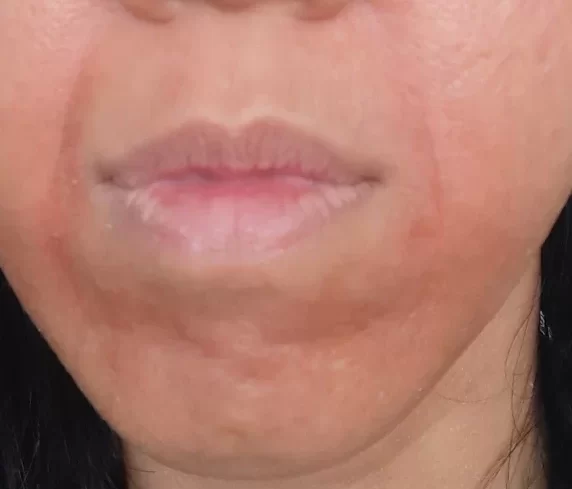Seborrheic dermatitis, or seborrhea, is a common skin condition that results in inflammation and scaling of the scalp, face, and neck. Although the patches hurt, they are not always uncomfortable.
In most cases, seborrheic dermatitis doesn’t hurt. However, in a severe flare, seborrheic dermatitis can cause pain. Burning most often occurs when you wash your face or apply a cream. Some treatments for seborrheic dermatitis, such as moisturizer and topical corticosteroids can help reduce the sting.
Let’s take a deep dive:
What are the symptoms of seborrheic dermatitis?
Seborrheic dermatitis usually affects areas with high numbers of sebaceous glands. These areas include the scalp, face (in the T-zone or U-zone, or both), neck, upper back and chest, armpits, and even the groin.
The symptoms of seborrheic dermatitis can vary depending on the person, but some common symptoms include:
- Red, inflamed skin
- Itching or burning sensation
- Dry, flaky skin
- Silvery scales on an oily base
- Dandruff on the scalp
- Crusts or scales on facial hair
- Greasy scaling on the sides of the nose
- Skin swelling in severe cases
Further reading: What characterizes seborrheic dermatitis?
Can seborrheic dermatitis be painful?
Seborrheic dermatitis can be painful, and some people experience intense itching. Many people mistakenly believe that seborrheic dermatitis is always mild and non-painful. However, in severe cases, seborrheic dermatitis can be very painful.
The condition is associated with skin inflammation, which can lead to a lot of discomfort. In addition, the flaking and scaling that are characteristic of seborrheic dermatitis can be quite itchy.
Scratching can injure your skin. SD can also cause painful fissures to form in your skin, especially at the nasolabial folds.
Why does seborrheic dermatitis hurt?
Many people with seborrheic dermatitis don’t understand why the condition hurts so much but there are a few reasons why SD can burn:
- The local inflammation that occurs on your skin causes pain, swelling and redness. Sometimes your skin might even feel warm.
- As your skin cells shed and new ones grow, the ‘new skin’ can feel tight and dry, causing discomfort and sometimes pain.
- When you scratch, you injure your skin further, causing stinging and burning, especially when you apply a cream or wash your face.
- Fissures can form in your skin, especially at the naso-labial folds and neck folds. These are definitely the most painful of the lot.
I had really painful nasolabial fissures. After a bad SD flare, they are usually the last ones to go:

How do you stop seborrheic dermatitis from burning?
The best way to stop SD from hurting is to prevent a flare up (duh).
Failing that, this is what you can do to soothe your skin and prevent your face and neck from hurting so much:
- Try your best not to scratch. Scratching begets scratching. The more you scratch, the more you itch. And all that scratching injures your skin, worsening and prolonging your pain.
- Use a gentle face wash or soap. Some people find Dove soaps doesn’t strip the natural oils off their skin.
- Apply a gentle moisturizer regularly, every 1-2 hours if you need to, to keep your skin moist and hydrated. As the skin barrier is impaired, your skin dries out very quickly. Check out my review of the best moisturizers for seborrheic dermatitis.
- Avoid using creams with chemicals, fragrances and other unnecessary active ingredients. I slather MooGoo Scalp Cream on every 2 hours (every hour in air conditioning) during my flares.
- Avoid exfoliating, keratolytics and using any other product that can slough off your skin surface.
- If you are using tea tree oil as an antifungal and it stings too much, dilute it further.
- Apply a topical antifungal cream twice a day. Even though it can sting when you use it, it will heal your flare quicker.
- You can use hydrocortisone cream to soothe the inflammation. However, please use steroid creams sparingly as it can cause a rebound flare if used regularly.
- If possible, stay out of the sun, wind and harsh environments. Your affected skin basically has no clothes on (no protective barrier) and will be easily damaged further.
- Drink at least 2 litres of fluid a day to keep as hydrated as possible.
To wrap up
Unfortunately, seborrheic dermatitis can hurt during a flare up. Bear in mind that no matter how much it stings, it’s temporary. My SD has given me a lot of pain and grief. My heart goes out to you. Keep strong. You will get through this. Once the flare is over, start working on preventing the next one.
 Check it out on Amazon
Check it out on Amazon Check it out on Amazon
Check it out on Amazon
Pingback: Does moisturizer help seborrheic dermatitis?
Pingback: The Best Moisturizers For Seborrheic Dermatitis
Pingback: Facial for seborrheic dermatitis
Pingback: What characterizes seborrheic dermatitis?
Pingback: Tea tree oil for seborrheic dermatitis: Is it good or bad?
Pingback: It's Now Easier Than Ever To Figure Out Seb Derm (18/06/2023)
Pingback: Does Seb Derm Hurt? Yes It Does (23/07/2023)